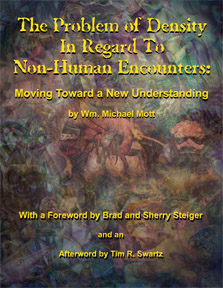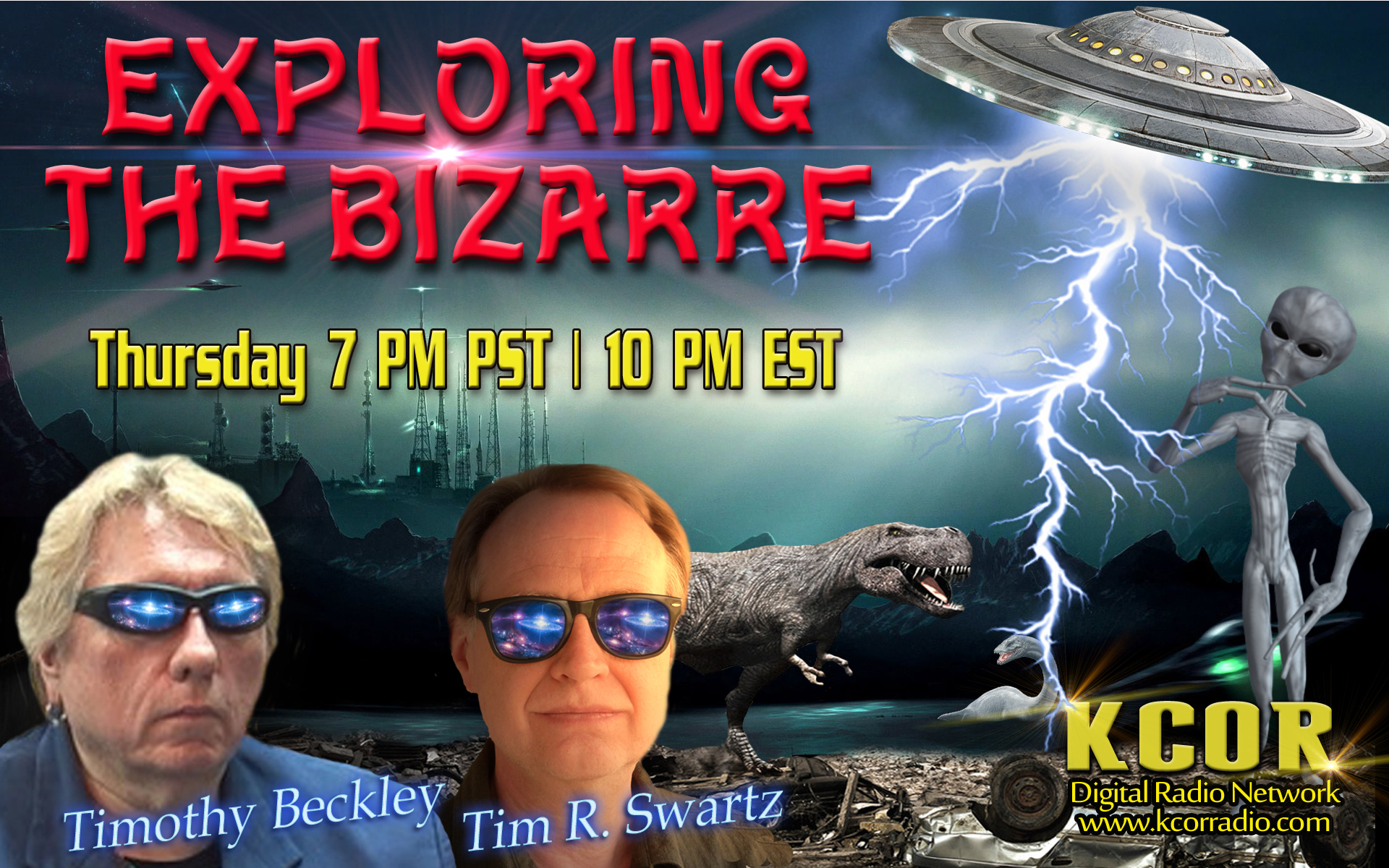Sign
up today for Bizarre Bazaar and Conspiracy
Journal
Magazines

8/30/20 #1060
http://www.conspiracyjournal.com
Subscribe for free at our subscription page:
http://www.members.tripod.com/uforeview/subscribe.html
You can view this newsletter online at:
https://uforeview.tripod.com/conspiracyjournal1060.html
“The popular notion that ghosts are likely to
be seen in a graveyard is not borne out by
psychical research... A haunting ghost usually
haunts a place that a person lived in or
frequented while alive... Only a gravedigger's
ghost would be likely to haunt a graveyard.”
- John H. Alexander, Ghosts! Washington Revisited: The Ghostlore of the Nation's Capitol
- John H. Alexander, Ghosts! Washington Revisited: The Ghostlore of the Nation's Capitol
This week
Conspiracy Journal brings you such fantastic
tales of weirdness as:
- Horses Killed in Bizarre Ritual-Like Mutilations -
- Studying the Intelligence of the Octopus -
- Japan’s ‘Bigfoot’ Still Influences Hiroshima Town -
AND: Mystery of the Alien Satellite
All these exciting stories and MORE in this week's issue ofCONSPIRACY JOURNAL!
~ And Now, On With The Show! ~

SPECIAL
- TWO BOOKS FOR THE PRICE OF ONE:
TIM BECKLEY'S BIZARRE AND UNEXPLAINED WORLDS
AND
THE CASE FOR UFO CRASHES
TIM BECKLEY'S BIZARRE AND UNEXPLAINED WORLDS
AND
THE CASE FOR UFO CRASHES
Act now to get these amazing books at our SPECIAL PRICE
of $24.00 (Plus $5 Shipping).
So Order Right Now Using PayPal From The Conspiracy Journal Bookshop and be amazed by the incredible color photos taken by the modest contactee.
 Click Here to
Order From the Conspiracy Journal Bookshop.
Click Here to
Order From the Conspiracy Journal Bookshop.
- MYSTERIOUS MUTILATIONS DEPARTMENT -
Horses Killed in Bizarre Ritual-Like Mutilations
Horses Killed in Bizarre Ritual-Like Mutilations

A series of gruesome horse and pony killings in France have left police baffled and the equine community gripped by fear.
Up to 30 incidents have been reported in pastures across the country, including ears being sliced off, eyes removed, genitals cut, sides slashed and blood being drained.
No meat is taken from the carcasses.
Some of the horrific acts could have been ritual mutilations by an unknown cult, while there are other theories about a "chilling" challenge on social media, or copycat crimes.
In the majority of attacks, an ear - usually the right one - has been sliced off, echoing matadors taking trophies in a bullring.
Agriculture minister Julien Denormandie said he was "excluding nothing" in the investigation and "all means are in motion to end this terror".
He added: "Ears are cut off, eyes removed, an animal is emptied of its blood."
The crime locations range from the mountainous Jura region in the east to the Atlantic coast in the west, with many taking place during this summer.
A police spokeswoman in Paris said: "We do not understand the motivation. Is it a satanic rite, insurance fraud, some macabre trophy hunt or an internet challenge? We don't know. It is very traumatising."
There is speculation about how such barbaric acts, some surgical in nature, could be carried without knowledge of equine anatomy or on a horse that could presumably flee.
Veterinarian Aude Giraudet, chief of the equine division at the National Veterinary School of Alfort, said: "A fearful horse in a pasture won't get caught.
"The horse who feels confident with people ... he'll come, find it normal that you put a harness on it or a rope around its neck. I'm not sure you need great knowledge of horses."
She said an ear can be cut off while the horse is standing, but the animal would need to be prostrate for more grisly mutilations.
A man confronted two attackers at his animal refuge last Monday in a village in the Bourgogne-Franche-Comte region.
The pair fled in a vehicle.
Nicolas Demajean suffered an arm injury during a struggle with one intruder who had a knife, as the other slashed the sides of two ponies, who are traumatised but recovering.
He told TV station France 3: "I used to have confidence putting my horses out to pasture. Today, I have fear in my gut."
The following day, a young pony was targeted in the Saone-et-Loire region. In another case, some of a horse's organs were removed.
The president of the French Federation of Equitation has offered to help police investigate the cases.
"We're all afraid," said Veronique Dupin, an official of a riding club in the Yvelines region west of Paris, asking that the exact location of the stable not be identified.
Similar cases occurred earlier this year in central Florida where in the span of a couple of weeks, horses in three counties were stolen, killed and butchered, ravaged bodies or severed heads left behind. The news rattled owners and caretakers who feared they’d be next.
The first body was found on Thanksgiving Day in 2019, in a pasture south of Ocala. It belonged to HotRod, a 21-year-old paint gelding, according to news reports. Someone had removed his skin. The cuts were clean.
Four days later, someone forced through a locked gate on a farm in Palmetto and stole a horse. One of the owners found the horse butchered in a nearby field, said Steve Stephens, a friend and neighbor. In an incident report, Manatee County Sheriff’s deputies wrote that the killers had “harvested most of the meat.”
Then, on Dec. 11, a Bushnell horse boarder woke to find that one of the horses on her property, 11-year-old Jayda, was missing. She followed tracks and droppings across the street and through a cut fence onto another property, until she reached a creek a half-mile in. Knowing Jayda feared water, she followed the edge of the creek to a hastily constructed pile of branches. Underneath, she found the horse’s mangled corpse.
On Facebook, frightened horse owners posted about unsettling incidents in other counties — a fence cut in Brooksville, suspicious passersby in Plant City. They speculated about ritual sacrifice and posited that the killings might be the work of one person moving up and down I-75. Some posted the license plates of cars they said had driven by their properties too slowly. One user said she trailed a “suspicious” vehicle for miles, to let the driver know they’d been seen.
Suspicions that the horses were being killed for their meat with one expert saying that there are upward of 500 illegal horse slaughter operations in Florida. Despite being taboo in the U.S., horse meat has roles in cuisines across the world. There is also the belief that horse meat has medicinal qualities, and the demand for black-market meat can push prices to $40 per pound.
Source: Sky News
https://news.sky.com/story/france-horses-killed-in-mysterious-ritual
-like-mutilations-12059258
- ALIENS IN OUR MIDST -
Studying the Intelligence of the Octopus
Story produced by Amy Wall
Editor: Joe Frandino

It's one of the most bizarre
creatures on Earth, and not just because it looks so different. The
octopus can camouflage itself in a flash; squeeze its entire body
through a one-inch hole; and their brains? That's right, an octopus has
one large central brain, and eight mini-brains, one in each arm.
"Octopuses are so brilliant," said author and naturalist Sy Montgomery, who believes their intelligence is almost off the charts.
"We give 'em the same toys to play with that we give our children," Montgomery said. "They love to play. Play is one of those characteristics of higher minds."
Rudy, a giant Pacific octopus, was one of the stars of the New England Aquarium in Boston, before she passed away recently from old age. When correspondent Chip Reid visited last year, Rudy seemed to want to play with us.
Reid said, "Some people go, 'Eeeww, that's creepy.' You go …?"
"I say, this is one of the most beautiful creatures on this planet, one of the smartest, one of the most interesting, and one of the most alien," Montgomery replied.
"In fact, they're portrayed in movies as aliens," said Reid.
"That's right, and as monsters."
Yes, Hollywood octopuses have torn down the Golden Gate Bridge, destroyed ships, and feasted on movie stars. Montgomery says it's unfair to demonize them: "You would really have to go to outer space to come up with someone more different from us than this. Their mouths are in their armpits; they have three hearts; they have blue blood. And the grace? I mean, who has grace like this?"
Montgomery spent countless hours studying these other-worldly beings while writing her book, "The Soul of an Octopus."
the-soul-of-an-octopus-simon-and-schuster-244.jpg
Simon & Schuster
Reid asked, "Do you believe the octopus has a soul?"
"I believe if I've got a soul, this octopus has a soul," she replied.
And that, she claims, is not the only thing they have in common with humans.
"When I met an octopus for the first time, I was so struck by the fact that she was just as curious about me as I was about her," Montgomery said.
Reid went behind the scenes to see for himself, with the help of senior aquarium biologist Bill Murphy. It turns out that calling an octopus curious is an understatement.
"Ahhh, she's more interested in you than the food!" said Murphy.
"That's scary," Reid replied.
It was as if she wanted Reid to join her in her octopus' garden. "She is powerful," he said.
"Yeah, you feel the pull in the muscle?"
A big part of Murphy's job is keeping Rudy from getting bored. "Because they're so smart, we try and keep them mentally stimulated," he said. "And interactions like this help with that, 'cause they're figuring us out and who we are and what we're doing."
There are about 300 species of octopus, but the giant Pacific octopus is the largest, averaging 16 feet in length, and 110 pounds. It's also the longest-lived octopus; even so, its life span is only about three to five years.
"They have such personalities," Murphy said. "Each octopus is different. So, when you work this closely with them and you're interacting with them on a regular basis, you build a relationship with them."
"That's gotta be difficult that they live such short lives," said Reid.
"It is. It is. It's very difficult. But you enjoy the time you have."
To learn more, Reid headed down to Cape Cod where he met Bret Grasse of the Marine Biological Laboratory in Woods Hole, Massachusetts. He's responsible for the care and feeding of the lab's octopuses, and stocks up on their favorite food: tiny grass shrimp.
Next stop: the beach for another octopus delicacy – crabs.
Back at the lab, the day was about to get a lot better for a small California two-spot octopus – and a lot worse for one of those crabs.
Of all the octopus' oddities, perhaps the most extraordinary is its talent for disguise. The octopus changes its shape, colors, patterns, even the texture of its skin, to look like seaweed, and does it in the blink of an eye. It's called dynamic camouflage.
"I would argue that dynamic camouflage is a form of intelligence," said Roger Hanlon, senior scientist and a top octopus researcher at the Marine Biological Laboratory, who recently gave a TED Talk on octopus intelligence that went viral:
Reid met him at the lab in Woods Hole, where he helped us understand what that means.
"It doesn't just happen instinctively; they actually think and decide how to camouflage themselves?" Reid asked.
"That's right. This is not a reflex; this is a decision-making process," Hanlon said. "They're taking into account the [surroundings] for camouflage, but also an approaching threat. And they're calculating all along about what they're going to do next."
As a scientist, Hanlon is skeptical about attributing human-like emotions to the octopus, or comparing their level of intelligence to ours. But he says they are stunningly creative.
He said, "This is a complex animal. It's making decisions all the time. That takes a big brain."
A big brain in a unique and mysterious creature that scientists are only beginning to understand.
* Thanks to Kevin Smith for this story.
Source: CBS News
https://www.cbsnews.com/news/studying-the-creativity-and-intelligence
-of-the-octopus-8-30-2020/
"Octopuses are so brilliant," said author and naturalist Sy Montgomery, who believes their intelligence is almost off the charts.
"We give 'em the same toys to play with that we give our children," Montgomery said. "They love to play. Play is one of those characteristics of higher minds."
Rudy, a giant Pacific octopus, was one of the stars of the New England Aquarium in Boston, before she passed away recently from old age. When correspondent Chip Reid visited last year, Rudy seemed to want to play with us.
Reid said, "Some people go, 'Eeeww, that's creepy.' You go …?"
"I say, this is one of the most beautiful creatures on this planet, one of the smartest, one of the most interesting, and one of the most alien," Montgomery replied.
"In fact, they're portrayed in movies as aliens," said Reid.
"That's right, and as monsters."
Yes, Hollywood octopuses have torn down the Golden Gate Bridge, destroyed ships, and feasted on movie stars. Montgomery says it's unfair to demonize them: "You would really have to go to outer space to come up with someone more different from us than this. Their mouths are in their armpits; they have three hearts; they have blue blood. And the grace? I mean, who has grace like this?"
Montgomery spent countless hours studying these other-worldly beings while writing her book, "The Soul of an Octopus."
the-soul-of-an-octopus-simon-and-schuster-244.jpg
Simon & Schuster
Reid asked, "Do you believe the octopus has a soul?"
"I believe if I've got a soul, this octopus has a soul," she replied.
And that, she claims, is not the only thing they have in common with humans.
"When I met an octopus for the first time, I was so struck by the fact that she was just as curious about me as I was about her," Montgomery said.
Reid went behind the scenes to see for himself, with the help of senior aquarium biologist Bill Murphy. It turns out that calling an octopus curious is an understatement.
"Ahhh, she's more interested in you than the food!" said Murphy.
"That's scary," Reid replied.
It was as if she wanted Reid to join her in her octopus' garden. "She is powerful," he said.
"Yeah, you feel the pull in the muscle?"
A big part of Murphy's job is keeping Rudy from getting bored. "Because they're so smart, we try and keep them mentally stimulated," he said. "And interactions like this help with that, 'cause they're figuring us out and who we are and what we're doing."
There are about 300 species of octopus, but the giant Pacific octopus is the largest, averaging 16 feet in length, and 110 pounds. It's also the longest-lived octopus; even so, its life span is only about three to five years.
"They have such personalities," Murphy said. "Each octopus is different. So, when you work this closely with them and you're interacting with them on a regular basis, you build a relationship with them."
"That's gotta be difficult that they live such short lives," said Reid.
"It is. It is. It's very difficult. But you enjoy the time you have."
To learn more, Reid headed down to Cape Cod where he met Bret Grasse of the Marine Biological Laboratory in Woods Hole, Massachusetts. He's responsible for the care and feeding of the lab's octopuses, and stocks up on their favorite food: tiny grass shrimp.
Next stop: the beach for another octopus delicacy – crabs.
Back at the lab, the day was about to get a lot better for a small California two-spot octopus – and a lot worse for one of those crabs.
Of all the octopus' oddities, perhaps the most extraordinary is its talent for disguise. The octopus changes its shape, colors, patterns, even the texture of its skin, to look like seaweed, and does it in the blink of an eye. It's called dynamic camouflage.
"I would argue that dynamic camouflage is a form of intelligence," said Roger Hanlon, senior scientist and a top octopus researcher at the Marine Biological Laboratory, who recently gave a TED Talk on octopus intelligence that went viral:
Reid met him at the lab in Woods Hole, where he helped us understand what that means.
"It doesn't just happen instinctively; they actually think and decide how to camouflage themselves?" Reid asked.
"That's right. This is not a reflex; this is a decision-making process," Hanlon said. "They're taking into account the [surroundings] for camouflage, but also an approaching threat. And they're calculating all along about what they're going to do next."
As a scientist, Hanlon is skeptical about attributing human-like emotions to the octopus, or comparing their level of intelligence to ours. But he says they are stunningly creative.
He said, "This is a complex animal. It's making decisions all the time. That takes a big brain."
A big brain in a unique and mysterious creature that scientists are only beginning to understand.
* Thanks to Kevin Smith for this story.
Source: CBS News
https://www.cbsnews.com/news/studying-the-creativity-and-intelligence
-of-the-octopus-8-30-2020/
- BIGFOOT ACROSS THE WORLD DEPARTMENT -
Japan’s ‘Bigfoot’ Still Influences Hiroshima Town After 50 Years
By Kohei Higashitani
Japan’s ‘Bigfoot’ Still Influences Hiroshima Town After 50 Years
By Kohei Higashitani

SHOBARA, Hiroshima Prefecture—A nighttime drive on a mountain path half a century ago led to a legend that forever changed this community and could now be instrumental in its survival.
On the evening of July 20, 1970, a man in a pickup truck in Saijo, a northern town of Hiroshima Prefecture, came across a rather unsettling sight: an ape-like creature walking on a mountainside.
After word spread about the encounter, other locals came forward with their own reports of an animal walking upright.
Their descriptions were similar. The beast was around 1.6 meters tall, with a gorilla-like body and a face shaped like an inverted triangle.
The locals started calling the creature “Hibagon,” a reference to Hiba mountain in the town.
Did Japan have its own Bigfoot or Sasquatch, the missing link in the evolutionary chain between apes and humans?
News and entertainment media began flooding the small town surrounded by mountains to find out.
The locals’ lives were turned upside-down by the sudden attention. But that was only the beginning of “Hibagon fever.”
Saijo town, today’s Saijocho district in the city of Shobara in Hiroshima Prefecture, became inseparable from the creature.
Residents today still talk about the legend of Hibagon.
CURSE OR RUNAWAY GORILLA?
Seiko Fujikawa, 56, was a first-year elementary pupil when Hibagon fever took the town by storm.
Fujikawa recalls that when he and his fellow students walked home from school in a group, they often found themselves pestered by questions from adults.
“Have you seen any holes around here?” the grown-ups asked the children in hopes of finding a trace of Hibagon or its den.
Fujikawa said those days were surreal.
Some residents believed that Hibagon represented a symbol of disapproval for the huge recreational facilities under construction in the area, including camping grounds.
“The god of Hiba mountain sent Hibagon to haunt us,” one theory went.
But Fujikawa mentioned another less-spiritual school of thought.
According to a rumor, a gorilla had escaped from Asa Zoo in the city of Hiroshima, which is 90 km from Saijo.
“And I heard that’s Hibagon’s true identity,” Fujikawa said. “We were scared of Hibagon, but it was all in good fun. It’s a sweet memory, indeed.”
‘NUISANCE MONEY’
Katsuyuki Egi, 76, was a young employee at the Saijo town government office when he was called to the mayor’s office in August 1970.
It was right after a local newspaper, The Chugoku Shimbun, ran a story about a Hibagon sighting in the town.
“It’s good that (Hibagon) is making it to the newspapers but …,” the bewildered mayor said.
Hibagon fever was rising, and day and night, reporters hounded residents who said they had witnessed the beast. Some reporters even knocked on doors at night or trespassed on fields, interfering with farm work.
The townsfolk began grumbling about the intense and constant national attention on Saijo.
The Saijo government decided to create a post to handle the “issue of anthropoid apes.”
Egi was appointed to the position.
His work included interviewing people who reported seeing Hibagon and handling inquiries and requests from visiting media and student members of a university “exploring club.”
Egi was previously in charge of tax services, so the topic of “anthropoid apes” was completely out of his domain.
“But it was fun,” he said. “My job was kind of like a jack of all trades. Looking back, I’d say it was a once-in-a-lifetime experience.”
Back then, residents in some parts of the mountain town did not have access to television. Egi himself never watched TV until he graduated from high school.
His first job at the town government office, in fact, was to install TV antennas in the mountains.
Hibagon fever, which coincided with the high-growth period of the postwar Japanese economy, spread the use of televisions in Saijo.
Residents became glued to the tube, and started enjoying the fame again, exclaiming, for example, “My neighbor was on TV!”
The town government in the meantime came up with a unique policy to pay 5,000 yen ($48) for each resident who spotted the creature. The money was to “make up for inconvenience” caused by a Hibagon sighting.
It was an exceptional offer considering the starting monthly salary for a town government employee back then was 14,900 yen, Egi said.
Although the payments raised suspicions of bogus sightings, Egi personally knew some of the witnesses very well.
“They were above lying, I can tell you that,” he said.
By October 1974, the town office had received 29 reports about Hibagon appearing in the wild.
But then, the sightings completely stopped.
“Hibagon fever is over,” the town officially declared in June 1975, five years after the first sighting.
Hibagon was never caught, even on film. The creature’s true identity has remained wrapped in mystery.
ANNIVERSARY PLANS
“Hibagon is a symbol of our town,” said Egi, who still lives in the area.
“I’m blessed with six grandchildren. I believe Hibagon, too, is living peacefully somewhere deep in the mountains, surrounded by grandchildren,” he said.
Egi’s sentiment is reflected all around the Saijocho district.
A character resembling Hibagon is ubiquitous in such places as gas stations, bus stops and souvenir shops.
“The young generation may not be familiar with Hibagon at all, but Saijo is the town of Hibagon,” said Kazuo Yamaguchi, 49, who heads the nonprofit organization Saijo Sightseeing Association.
Yamaguchi was born and raised in Saijo. But he spent his high school and college days in Hiroshima city.
He was only an infant when Hibagon fever reached its peak, but he said he feels so proud of having Hibagon in his hometown.
In 2005, Saijo merged with other municipalities and became part of the city of Shobara.
At the end of June, 3,262 people lived in the Saijocho district, a 35 percent decrease from the population 20 years ago.
As part of revitalization efforts, Yamaguchi’s organization and the city government plan to host many events to mark the 50th anniversary of the first Hibagon sighting.
Tours to places where Hibagon was seen were on the agenda, but they were canceled because of the novel coronavirus pandemic.
Instead, Yamaguchi now plans to host an online tour in autumn to Hibagon-related locations and sightseeing spots. Egi will serve as a tour guide.
A commemorative publication that contains old newspaper articles and witness interviews is also expected to be released in fall.
Source: Asahi Shimbun
http://www.asahi.com/ajw/articles/13584940
PAYPAL
DISCOUNT FOR ORDERS FOR NEW
CONSPIRACY JOURNAL #50
CONSPIRACY JOURNAL #50
Hail! Hail! The latest print edition of the Conspiracy Journal (#50) is available. Either e-mail mrufo8@hotmail.com for a copy to go to your snail mail or browse right here, right now, on line. All orders will receive a 10% discount if placed through PayPal. Just deduct the amount before sending it in or we can send you a PayPal Invoice.
Our Finest Books and Other Items of Interest Now Available for Your Pleasure!
USE PAYPAL FOR QUICK AND EASY ORDERS!
We can also take
your credit card orders by your leaving a
message at 732 602-3407
Mystery of the Alien Satellite

-
COMING 'ROUND FOR A VISIT DEPARTMENT -
Mystery of the Alien Satellite

"Our homeland Sun is Epsilon Bootes. It is a
double star.
We live on sixth of seven planets, counted from the sun… Our sixth planet has a moon, our fourth planet has three moons. Our first and third planet has no moon.
Our satellite is in a circular path around your Moon… "
Did we pick up the signals from an artificial satellite sent to our planet by an extraterrestrial intelligence?
In December 1927, Carl Stoermer, the Norwegian Professor of Mathematics at University in Olso, and explorer of echo radio was contacted by two American scientists, Leo C. Young, radio engineer and Dr. A. Hoyt Taylor, chief consultant of electronics at the naval research laboratory.
During their experiments with radio waves, Young and Taylor observed unnatural signals coming from space.
On August 25 1928, the scientists along with Carl Stoermer and the workers of Philips Company began to send their own radio signals of various wave lengths.
While sending a series of signals, the researchers received two series of echoes instead of only one, normally coming back after a delay of one seventh of a second.
Weeks passed and on October 11, 1928, the same repeating signals with delays from 3 to 15 seconds were systematically received during several sessions. On October 24, as many as 48 such signals were picked up.
The interval from 3 to 15 seconds was a real puzzle to the scientists. Could they mean a code, an intelligent coded message from an unknown extraterrestrial sender? But from whom? What was the location of the signals?
The observations of incoming signals were still conducted in 1934, 1947, 1949, and 1970.
At the beginning of the 70s, Duncan Lunan, a Scottish astronomer, President of the Scottish Association of Technology and Research, being interested in the phenomenon undertook a thorough research.
The puzzling phenomenon required an explanation of some kind, but all attempts to solve it did not bring any satisfying results. Lunan's approach was different.
Instead of to register the deceleration time in the Y-axis (as the scientist usually practise), Lunan drew the time delay on October 11, 1928, of the received indications… in the X-axis.
The obtained results were shocking.
The signals received on October 11, 1928, originated from the constellation of Bootes (the Herdsman - the Bear Watcher, in Greek), located in the northern sky, dominated by the bright orange giant star Arcturus.
Arcturus of magnitude 0.04 is the fourth brightest star in the sky.
The constellation of Bootes is suggested to be the oldest known constellation listed by Ptolemy (ca. AD 140). Not as widely known as for example Cassiopeia or Orion, Bootes still has its impressive past recorded in history.
The ancient Egyptians pictured Bootes as a constellation they called the Hippopotamus. Both the Hindus and ancient Chinese regarded Arcturus as a pearl-star. The Greeks knew Bootes as the Bear Watcher.
Based on the results, Duncan Lunan created six detailed sky maps, depicting the set of stars in the constellation of Bootes. However, he came upon yet another mystery…
Comparing all data available from his and earlier observations, he discovered two important though strange deviations in the view of star positions. Such deviations could not be, but they were.
Looking at the first deviation, Lunan noticed that the point that should represent the star Artcturus, the brightest one in the constellation was outside of its current position.
He was surprised. He analyzed once again the star positions and found the answer. He was looking at the position of the star Arcturus as it was registered 12,500-13,000 BC!
That was the time at the end of the last large Ice Age.
A new chapter of our planet's history has just begun then. Time of the Sphinx, the pyramids, and perhaps the city of Tiahuanaco, however the last could be even older…
The other deviation was related to the star Izar, a yellow K1 giant star, a binary companion to Arcturus. The point, which should represent the star Izar was not noted on the design, but outside of the constellation lines. This point was the exact result of radio echo of 3 seconds delay, while the other points were represented by radio echoes from 8 to 15 of delay.
Was the star Izar referring to the sun of the unknown civilization in the constellation Bootes?
Perhaps a technologically advanced intelligence from there built and sent an artificial satellite to our solar system. Radio signals sent on separate occasions from the alien satellite reached the Earth's surface and bounced back to the alien satellite. After being registered and deliberately delayed, they were repeatedly sent back to the Earth.
Already in 1960, Professor R.N. Bracewell of Stanford University, California suggested that if an extraterrestrial civilization decided to contact us, they would probably choose to do it by using delayed radio signals.
No doubt, the probe was dispatched to orbit in the vicinity of Earth. The question is: For what purpose? For listening and watching our technological and social progresses? For future contact with us?
Perhaps this contact has already been established. We do not know...
Source: UFO Area
http://www.ufoarea.com/et_search_and_contact_aliensat.html
We live on sixth of seven planets, counted from the sun… Our sixth planet has a moon, our fourth planet has three moons. Our first and third planet has no moon.
Our satellite is in a circular path around your Moon… "
Did we pick up the signals from an artificial satellite sent to our planet by an extraterrestrial intelligence?
In December 1927, Carl Stoermer, the Norwegian Professor of Mathematics at University in Olso, and explorer of echo radio was contacted by two American scientists, Leo C. Young, radio engineer and Dr. A. Hoyt Taylor, chief consultant of electronics at the naval research laboratory.
During their experiments with radio waves, Young and Taylor observed unnatural signals coming from space.
On August 25 1928, the scientists along with Carl Stoermer and the workers of Philips Company began to send their own radio signals of various wave lengths.
While sending a series of signals, the researchers received two series of echoes instead of only one, normally coming back after a delay of one seventh of a second.
Weeks passed and on October 11, 1928, the same repeating signals with delays from 3 to 15 seconds were systematically received during several sessions. On October 24, as many as 48 such signals were picked up.
The interval from 3 to 15 seconds was a real puzzle to the scientists. Could they mean a code, an intelligent coded message from an unknown extraterrestrial sender? But from whom? What was the location of the signals?
The observations of incoming signals were still conducted in 1934, 1947, 1949, and 1970.
At the beginning of the 70s, Duncan Lunan, a Scottish astronomer, President of the Scottish Association of Technology and Research, being interested in the phenomenon undertook a thorough research.
The puzzling phenomenon required an explanation of some kind, but all attempts to solve it did not bring any satisfying results. Lunan's approach was different.
Instead of to register the deceleration time in the Y-axis (as the scientist usually practise), Lunan drew the time delay on October 11, 1928, of the received indications… in the X-axis.
The obtained results were shocking.
The signals received on October 11, 1928, originated from the constellation of Bootes (the Herdsman - the Bear Watcher, in Greek), located in the northern sky, dominated by the bright orange giant star Arcturus.
Arcturus of magnitude 0.04 is the fourth brightest star in the sky.
The constellation of Bootes is suggested to be the oldest known constellation listed by Ptolemy (ca. AD 140). Not as widely known as for example Cassiopeia or Orion, Bootes still has its impressive past recorded in history.
The ancient Egyptians pictured Bootes as a constellation they called the Hippopotamus. Both the Hindus and ancient Chinese regarded Arcturus as a pearl-star. The Greeks knew Bootes as the Bear Watcher.
Based on the results, Duncan Lunan created six detailed sky maps, depicting the set of stars in the constellation of Bootes. However, he came upon yet another mystery…
Comparing all data available from his and earlier observations, he discovered two important though strange deviations in the view of star positions. Such deviations could not be, but they were.
Looking at the first deviation, Lunan noticed that the point that should represent the star Artcturus, the brightest one in the constellation was outside of its current position.
He was surprised. He analyzed once again the star positions and found the answer. He was looking at the position of the star Arcturus as it was registered 12,500-13,000 BC!
That was the time at the end of the last large Ice Age.
A new chapter of our planet's history has just begun then. Time of the Sphinx, the pyramids, and perhaps the city of Tiahuanaco, however the last could be even older…
The other deviation was related to the star Izar, a yellow K1 giant star, a binary companion to Arcturus. The point, which should represent the star Izar was not noted on the design, but outside of the constellation lines. This point was the exact result of radio echo of 3 seconds delay, while the other points were represented by radio echoes from 8 to 15 of delay.
Was the star Izar referring to the sun of the unknown civilization in the constellation Bootes?
Perhaps a technologically advanced intelligence from there built and sent an artificial satellite to our solar system. Radio signals sent on separate occasions from the alien satellite reached the Earth's surface and bounced back to the alien satellite. After being registered and deliberately delayed, they were repeatedly sent back to the Earth.
Already in 1960, Professor R.N. Bracewell of Stanford University, California suggested that if an extraterrestrial civilization decided to contact us, they would probably choose to do it by using delayed radio signals.
No doubt, the probe was dispatched to orbit in the vicinity of Earth. The question is: For what purpose? For listening and watching our technological and social progresses? For future contact with us?
Perhaps this contact has already been established. We do not know...
Source: UFO Area
http://www.ufoarea.com/et_search_and_contact_aliensat.html

Click on banner to sign up for two FREE magazines!

Free Issue of Phenomena Magazine
www.mapit.kk5.org

Wm Michael Mott - New Book Available on Kindle
Conspiracy
Journal - Issue #1060 8/30/20
http://www.conspiracyjournal.com
Subscribe for free at our subscription page:
http://www.members.tripod.com/uforeview/subscribe.html
http://www.conspiracyjournal.com
Subscribe for free at our subscription page:
http://www.members.tripod.com/uforeview/subscribe.html


